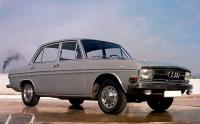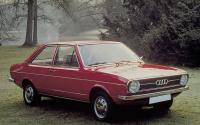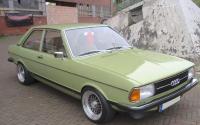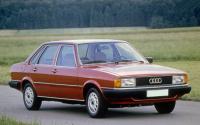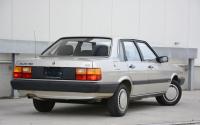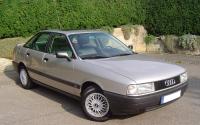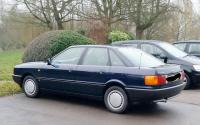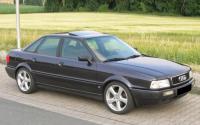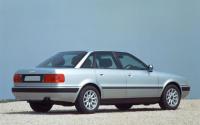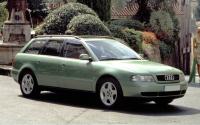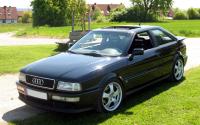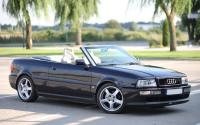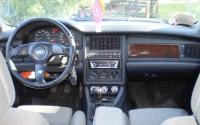The engines were gasoline carbureted and fuel injected, as well as atmospheric and turbocharged diesel engines with front-mounted and front-wheel drive. The bodies were originally sedan and station wagon (Avant), and then came the coupe and convertible. Also was «senior» brother - Audi 90 - a more expensive version with more powerful engines and more options.
Audi B1 (1973—1978)
Until 1973, the car was called the Audi F103, based on the DKW F102. It differed from the base with a four-stroke engine. In 1972, the Audi 80 was introduced in Europe, the following year in North America and Australia, competing with the Opel Ascona and Ford Taunus. In total, about 1.1 million copies were released.
The car was available as a sedan with two or four doors, as well as a station wagon with five doors. There were 3 options for engines - 1.3 and 1.5 liters with power from 55 to 85 hp. and 1.6 liters with 100 hp. All engines are 4-cylinder, located in front with front-wheel drive. Transmission automatic 3-speed or manual 4-speed.
MacPherson type front suspension and Panhard trailing arm C-beam rear fixed beam using coil springs and telescopic dampers.
In the autumn of 1976, the appearance of the front of the car was changed - round headlights were made square. A 1.6-liter engine with 75/85 hp was also added. A new model was also released - the Audi 80 GTE with a 1.6-liter injection engine. (110 hp).
Audi B2 (1978—1986)
In September 1978, Audi introduced a redesigned 80 based on the new B2 platform (Typ 81). In the US, the model became known as the Audi 4000. The body design was designed by the famous Italian designer Giorgetto Giugiaro. In total, about 1.7 million cars were produced.
The station wagon body type had to be abandoned, since this niche was firmly occupied by the Volkswagen Passat. Only 2 and 4 door sedan and coupe remained.
The number of engine options has increased significantly: gasoline 4-cylinders with a volume of 1.3 to 1.8 liters (60-93 HP), 5-cylinder volume from 1.9 to 2.2 liters (115-136 hp), and also a 1.6-liter diesel engine appeared as an atmospheric (54 HP), and turbocharged (70 HP). Transmission 4 and 5-speed manual and 3-speed automatic.
In 1983, the all-wheel drive model Audi 80 first appeared. The model turned out to be heavier and more expensive than the front-wheel drive Audi 100.
In 1984, a light facelift was made, which touched the rear and front headlights, both bumpers, instrument panel and steering wheel; moved the fuse box under the hood; For the first time, a catalytic converter appeared to reduce the toxicity of exhaust gases.
Audi B3 (1986—1991)
In September 1986, the third generation Audi 80 was introduced (B3, Typ 89). This platform no longer had anything to do with the B3 VW Passat platform and was completely independent. The body of the car has become more rounded: if the people called the previous modification «chisel», then this one was called «barrel». For the first time, the body was fully galvanized for corrosion protection, which resulted in an increase in the guarantee against corrosion to 12 years. Removed all other model names in other countries, only the Audi 80/90 names remained. For all the time, about 1.6 million cars were produced.
The 80th model had four 4-cylinder petrol engines of 1.4, 1.6, 1.8 and 2.0 liters with power from 64 to 135 hp. both carburetor and injection, and also three 4-cylinder diesel engines 1.6 and 1.9 (atmospheric) and 1.6 (turbine) power from 50 to 79 hp
In the 90th model, the engines were installed more powerful. Two petrol 5-cylinder engines of 2.0 and 2.3 liters (from 113 to 170 hp) and one 1.6-liter 4-cylinder turbodiesel with 79 hp.
The body was in two versions - a 4-door sedan and a 2-door coupe. Three transmission options - 4 and 5-speed manual transmission and 3-speed automatic.
Audi B4 (1991—1996)
A major update of the previous generation led to the appearance of the B4 upgrade (Typ 8C) in 1991. _ The wheelbase has increased, the fuel tank and the rear axle have been completely changed, which made it possible to use folding rear seats, new bumpers, better materials for interior trim have been used, and people have become better and more comfortable in the car. In general, a serious step has been taken into the premium segment, where only cars of companies competed with each other BMW And Mercedes-Benz.
In Europe, abandoned the name of the model «90», all machines were sold with branded «80». In the US, the picture is reversed - all models were sold under the brand name «90». Over a 5-year production period, about 1.1 million cars were produced. B4 was the last modification with the name «80». In 1994, a successor to this class appeared - Audi A 4.
B4 was produced in 4 body styles: 4-door sedan, 5-door station wagon, 2-door coupe and 2-door convertible. Front-wheel drive or permanent all-wheel drive called «quattro». Transmission in two versions: 5-speed manual or 4-speed automatic.
The range of gasoline engines has expanded. Inline 4-cylinders with a volume of 1.6 and 2.0 liters (from 71 to 140 hp). Inline 5-cylinder 2.3 liters (133 HP). V-shaped 6-cylinders with a volume of 2.6 and 2.8 liters with a capacity of 150 and 174 hp. respectively. Diesel engines two, each 1.9 liters, turbocharged (75 and 90 hp), on a more powerful one, direct injection began to be used. Also for the S2 and RS2 models, 2.2-liter gasoline engines with a capacity of 230 and 315 liters were used. with.

